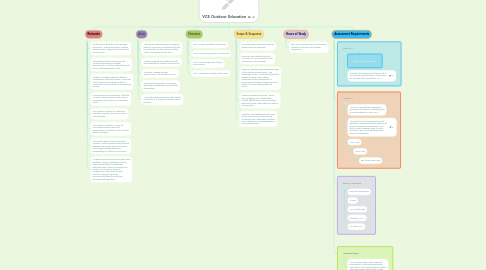VCE Outdoor Education
by Holly Mills

1. Assessment Requirements
1.1. Units 1 & 2
1.1.1. Satisfactory/ unsatisfactory
1.1.2. The level of achievement for these units is up ot the schools discression. These marks do not need to be reported to VCAA.
1.2. Units 3 & 4
1.2.1. "The VCAA specifies the assessment procedures for students undertaking the scored assessment in Units 3 & 4"
1.2.2. "Students level of achievement on each assessment component will be determined by School-assessed Coursework (SACs) and/or School-assessed Tasks (SATs) as specified in the VCE study designs and external assessments."
1.2.3. Unit 3: 25%
1.2.3.1. Unit 4: 25%
1.2.3.1.1. End if year exam: 50%
1.3. External Assessment
1.3.1. 50% end of year exam
1.3.2. 2 hours
1.3.3. VCAA Rules apply
1.3.4. Marked by VCAA
1.3.5. For unites 3 & 4
1.4. Assessment types
1.4.1. Journal, diary entries, case study, oral presentation, multimedia presentation, data analysis, structured questions, written responses, essays, web forums, written report
2. Hours of Study
2.1. Each unit involves 50 hours of scheduled classroom instruction and outdoor experiences
3. Aims
3.1. "develop an understanding of ecological, historical, economic and social factors that have affected and will continue to affect outdoor environments over time"
3.2. "develop experiential relationships with and knowledge of outdoor environments"
3.3. "conserve, manage outdoor environments in a sustainable manner"
3.4. understand implications of increasing awareness of sustainable environmental relationships"
3.5. "Critically analyse interactions with outdoor environments in shaping Australian cultural practices."
4. Scope & Sequence
4.1. The relationship/ interaction between people and he environment.
4.2. Students make critically informed comments on: environmental health, particularly in local contexts."
4.3. Students "develop experiential knowledge of the outdoor environments." This knowledge is then " enhanced through the theoretical study of the outdoor environments from perspectives of environmental history, ecology and social studies of human relationships with nature."
4.4. Outdoor experiences include: "farms, mining/logging sites, interpretation centres, coastal areas, rivers, mountains, bushland, forests, urban parks and state or national parks."
4.5. Activities: "bushwalking, cross-country skiing, canoe touring, cycle touring, conservation and restoration activities, marine exploration and participation in community projects."
5. Rationale
5.1. Students learn the skills and knowledge required to "safely participate in outdoor activities and to respect and value diverse environments."
5.2. Theory-based study is reinforced with "practical experience of outdoor environments" to :inform understanding of human relationships with nature."
5.3. Students "critically analyse the different relationships, effects and issues" in the uses of the environment so they are able to "participate and contribute to contemporary society."
5.4. Students study the modification of the the "outdoor environments to meet survival, commercial, conservation and recreation needs."
5.5. The outdoors is aplace of "adventure, relaxation. scientific study, social action and enterprise."
5.6. The outdoors provides a "space for connectedness with nature and opportunities for reflection upon the past, present and future.
5.7. The rand of uses and values about the outdoors "result in pressures and tensions between user groups, leading to issues concerning the preservation and sustainability of outdoor environments."
5.8. "Outdoor and Environmental Studies offers students a range of pathways including further formal study in areas where interaction with outdoor environments is central, such as natural resource management, nature-base tourism, outdoor leading and guiding, environmental research and policy, education and agriculture."
6. Structure
6.1. Unit 1: Exploring outdoor experiences
6.2. Unit 2: Discovering outdoor environments
6.3. Unit 3: Relationships with outdoor environments
6.4. Unit 4: Sustainable outdoor relationships

